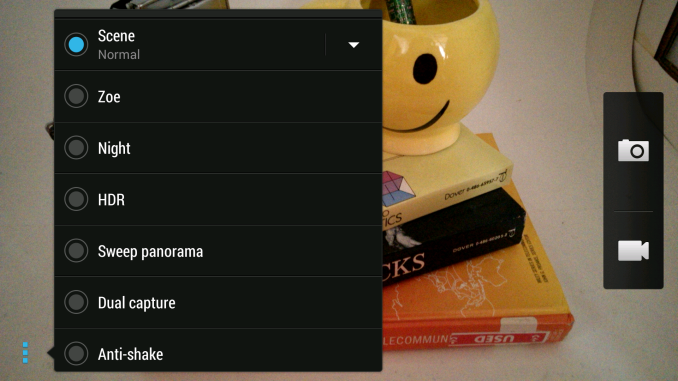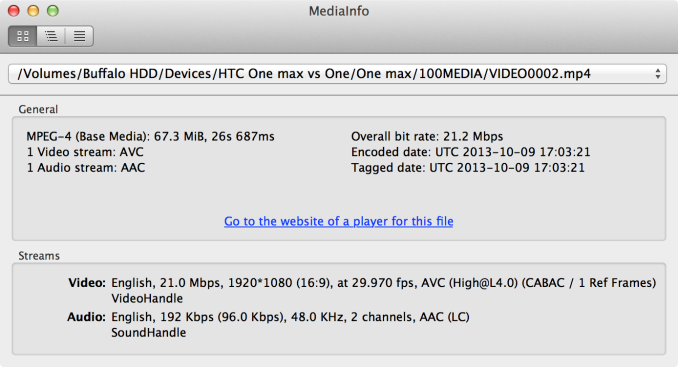HTC One max Review - It's Huge
by Brian Klug on October 28, 2013 10:00 AM EST- Posted in
- Smartphones
- HTC
- Mobile
- One
- Snapdragon 600
- Android 4.3
- One max
On the camera side we see HTC’s continued use of the 4 MP UltraPixel camera sensor on the back, with 2.0 micron pixels and 1/3" size. It’s the same CMOS sensor from ST (VD6869), and the same optics on top, with 3.8mm focal length and F/2.0 aperture. What’s different is that the One max doesn’t have OIS (Optical Image Stabilization), just like the One mini. That’s a bit unfortunate since OIS was one of the real highlights of the One, and we’ve seen another OEM follow suit with the inclusion of OIS to good success (LG’s G2) and will likely see Samsung do the same. On the front facing camera we have an Aptina AS0260 CMOS sensor with 2.1 MP resolution and 1.4µm pixels.
| HTC One Camera Specifications | |||||
| Device | HTC One | HTC One max/mini | |||
| Sensor Size and Type | 1/3" BSI CMOS | 1/3" BSI CMOS | |||
| Resolution | 4.0 MP 16:9 Aspect Ratio (2688 x 1520) | 4.0 MP 16:9 Aspect Ratio (2688 x 1520) | |||
| Focal Length | 3.82mm | 3.82 mm | |||
| F/# | F/2.0 | F/2.0 | |||
| Optical System | 5P | 5P | |||
| OIS | 2-axis +/- 1 degree, 2 kHz sampling | No OIS | |||
My thoughts about the HTC One camera system have definitely evolved over time, though I’m still glad HTC took a big risk and went this way, I’d like to see resolution traded off a bit less in the next generation. Good imaging often takes a balanced approach, I’d love to see larger pixels somewhere around 1.65 µm and as many as possible while still being pragmatic about sensor size. I hate to bring up the iPhone 5s as a comparison point, but something without as far of a tradeoff would be great. I’m still a fan of the HTC One camera indoors where other cameras struggle, but outdoors the resolution tradeoff is definitely there. Losing OIS means losing one of the things about the One system that made it special and standout in my mind. I could understand it being gone in the One mini for cost reasons, but the One max really should’ve had it considering its mission – everything about the One, taken to the max.
There’s a couple new features in the camera as a part of Sense 5.5 as well. Dual capture has been added to the camera as a shooting mode. We’ve seen this from other OEMs – it allows the front facing camera to be superimposed on the rear facing camera, or vice versus.
It’s a great feature for taking a selfie in front of something while traveling, which is ultimately its primary use case, I guess. There’s also an ‘anti shake’ mode which seems to be an EIS enhanced mode, but again this doesn’t preclude getting blurry pictures when the One max takes longer exposures, from what I’ve found.
Gallery: Smartphone Camera Bench
With the exception the performance tradeoff that comes from lacking OIS (higher chance of getting blurry photos from hand shake), imaging performance on the One max is really unchanged versus the One or One mini. I’m not going to go into super great detail here, but again I’d love to see the future One series a bit more resolution without trading off too much sensitivity.
Video
The One max has the same set of video modes as the other One, normal 1080p30, slow motion video, fast HD (720p60) and Video HDR (1080p30). In addition the shot in shot mode also works in video, so you can have yourself superimposed over video of whatever you’re shooting as well.
Video is recorded at a maximum of 1080p30 H.264 high profile with a 21 Mbps bitrate, and stereo audio. 1080p30 is great, but it’d be awesome to see 4K UHD video record which I was spoiled by on the Note 3, that’s another thing that’s a matter of SoC and CMOS needing a bit more.
I took videos on the One max at the standard bench location (MP4) and also compared to the One with OIS to illustrate the tradeoff in stabilized video that comes with its removal. I think it’s fairly easy to make the case that it should’ve been there. I also swear I wiped down the One max front facing glass to prevent glare, but the One max video shows some haze from light leakage. I’d love to see more OEMs move to coated sapphire cover glass on the camera, something I don’t believe HTC has.























































197 Comments
View All Comments
ddriver - Monday, October 28, 2013 - link
Doesn't seem to be doing well in its category (phablets that is) - considering devices already on the market and those soon to be launched, I'd guess the main selling point for this device will be brand loyalty. And people complained the note was too big...Omega215D - Tuesday, October 29, 2013 - link
The BoomSound speakers are much better than what the Note 3 puts out but you pay the price for them in extra height and possibly thickness. Also, HTC is pretty good at making the most of the battery capacity in which many of their phones have great standby times and good usage life.kmmatney - Tuesday, October 29, 2013 - link
The price may make a difference. I was planning on buying a note 3, but went for the LG Optimus Pro G because it was $200 cheaper at $99, and almost the same size screen. If the HTC One Max is $199, it might sway some buyers. I probably would have bought it just for the speakers.jshsimpson1 - Friday, November 15, 2013 - link
you missed out on the note 3Chaitanya - Monday, October 28, 2013 - link
a small typo on 1st page. Battery aint 1210mah, its 3300mah I believe.IanCutress - Monday, October 28, 2013 - link
1210 mAh is the Power Flip battery. 3300 mAh is the phone battery.MrCommunistGen - Monday, October 28, 2013 - link
If you're talking about this line: "The battery isn’t huge, at 1210 mAh and 3.75V (4.53 watt-hours), but it does give a boost as I’ll show in the battery section." he's referring to a battery + flip cover case.nerd1 - Monday, October 28, 2013 - link
One MAX - 164.5*82.5*10.29mm 217gGalaxy note 3 - 151.2*79.2*8.3mm 168g
I can understand the size but why that heavy and thick?
Johnmcl7 - Monday, October 28, 2013 - link
I was surprised at the thickness/weight as well, the larger Z Ultra comes in a lot thinner and a bit lighter despite the fact it has a larger 6.44in screen and fully weather sealed:Sony Z Ultra - 179.4 x 92.2 x 6.5 mm 212g
ShieTar - Monday, October 28, 2013 - link
Both the Note 3 and the Z Ultra are dead flat though, while the One Max has a nice curvature on the back. Its surely a question of personal reference which you prefer, personally I like the curved body better than something thin and flat.